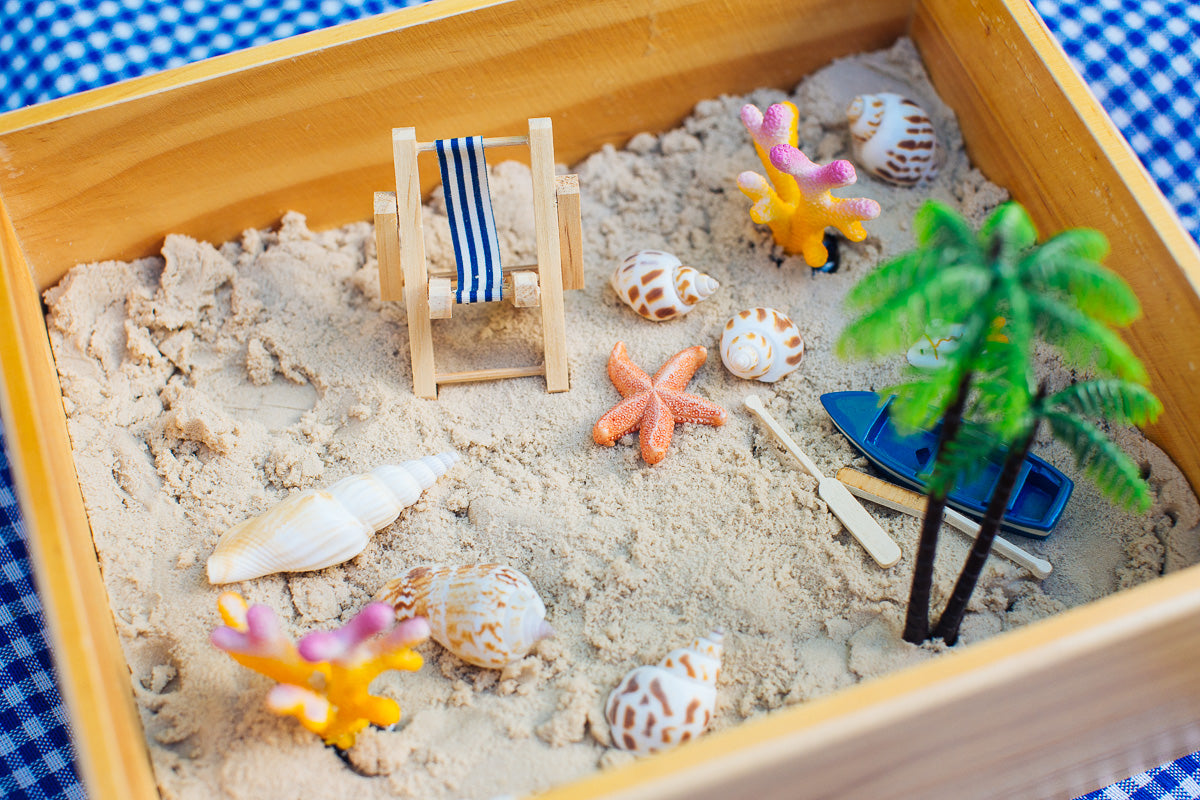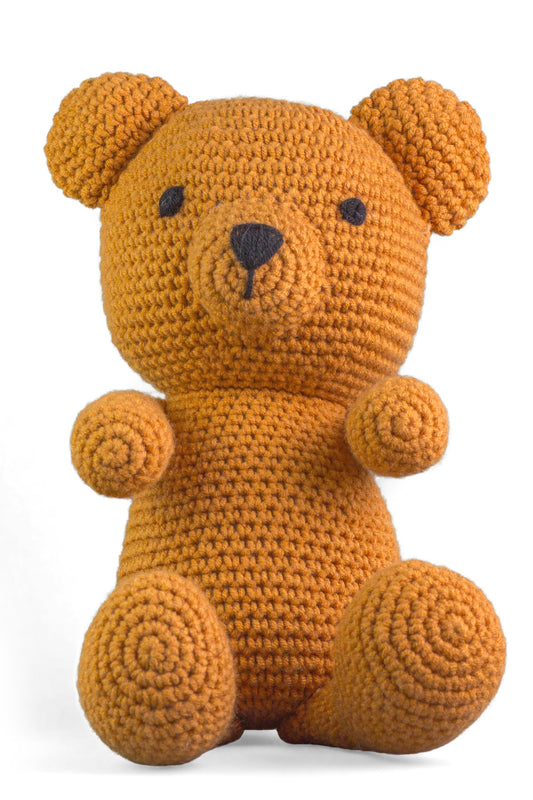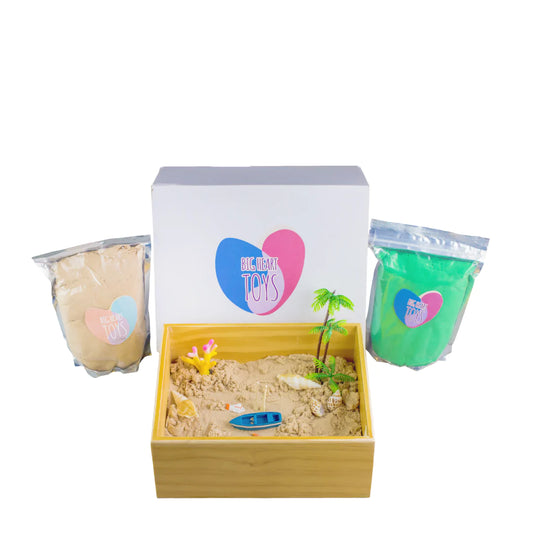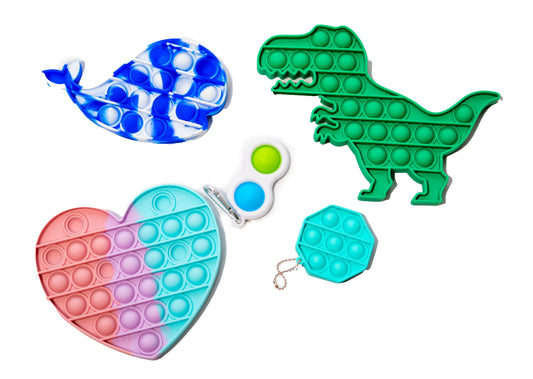
Tactile (Touch) & Sensory
Tactile and sensory toys are vital for children's cognitive and sensory development, allowing them to explore textures and refine tactile discrimination skills. These experiences not only stimulate neural pathways, improve sensory integration, fine motor skills, and hand-eye coordination, but also foster creativity, problem-solving, and cognitive development through imaginative play and cause-and-effect exploration.
Discover the unique sensory experiences offered by each toy below, promoting holistic cognitive and neurological growth in your child!
-
Weighted Gel Maze
Regular price $24.95Regular priceUnit price per -
Collapsible Ocean Sensory Bin
Regular price $24.95Regular priceUnit price per$24.95Sale price $24.95 -
Teddy Bear crochet
Regular price $28.95Regular priceUnit price per -
Hippo crochet
Regular price $28.95Regular priceUnit price per -
Sale
-
Fidget and Pop Toys Kit
Regular price $16.95Regular priceUnit price per$20.99Sale price $16.95Sale
Pop Toys
What Are Sensory Toys?
Sensory toys are specially designed playthings that stimulate and engage one or more of the five senses (sight, touch, hearing, taste, and smell). They are often used to support sensory development, provide sensory input, and promote relaxation and focus in children with sensory processing issues or developmental challenges. These toys come in various forms, such as textured or scented objects, noise-making instruments, and visually stimulating items, each catering to individual sensory needs and preferences.
Some of the different types of sensory include the following:
Sensory bins
Sand boxes or kits for kinetic sand
Fidget Toys for Tactile Stimulation
Fidget toys for tactile stimulation are small, portable gadgets designed to engage and soothe the sense of touch. These toys feature various textures, surfaces, and shapes, providing a satisfying sensory experience for users.
Whether it's smooth spinners or textured cubes, fidget toys offer a discreet way to ease anxiety, improve focus, and enhance fine motor skills. They have gained popularity among individuals of all ages, including children with attention disorders, autism, and sensory sensitivities. Thanks to their therapeutic benefits and enjoyable nature, fidget toys have become valuable tools for promoting relaxation and concentration in today's fast-paced world.
Sensory Balls for Hand-Eye Coordination
Sensory balls are dynamic playthings specifically designed to enhance hand-eye coordination in children and adults alike. These balls come in various sizes, textures, and colors, encouraging multiple types of sensory stimulation during play. By engaging in activities like catching, throwing, rolling, and bouncing these balls, individuals can improve their gross motor and fine motor skills, spatial awareness, and reflexes.
The tactile feedback and visual stimulation offered by sensory balls make them effective tools for occupational therapy, sports training, and recreational play. Whether you choose a squishy stress ball, a bumpy massage ball, or a brightly colored juggling ball, these versatile toys provide a fun and engaging way to develop essential hand-eye coordination skills for people of all ages and abilities.
Squishy Toys for Stress Relief
Squishy toys are wonderful stress-relief companions, designed to be squeezed, squashed, and manipulated to provide a soothing, calming effect. These soft, pliable toys come in various shapes, from animals to food items, and are usually filled with a squishy gel or foam material. When squeezed, they offer a tactile sensation that can help release tension and soothe anxiety.
Squishy toys are popular among children seeking a quick stress-relief fix or a sensory diversion. Many people find comfort in kneading and playing with these toys, which can serve as a subtle way to manage stress in various settings, like at home, school, or work. Their simple yet effective design makes squishy toys an accessible and enjoyable tool for achieving relaxation and emotional well-being.
Water Beads and Sensory Bins for Exploration
Water beads and sensory bins create a captivating world of exploration. Water beads are small, colorful polymer balls that expand when soaked in water, transforming into squishy, gel-like orbs. When placed in a sensory bin (a container filled with various materials like sand, rice, or water), they offer a multi-sensory experience that stimulates touch, sight, and even sound.
This sensory play has benefits for individuals of all ages. It aids in developing fine motor skills, hand-eye coordination, and spatial awareness. Additionally, it fosters sensory processing and emotional regulation, making it an excellent tool for children with sensory sensitivities or developmental challenges.
Pop Tubes and Pop It Toys for Auditory and Tactile Sensations
Pop tubes and pop it toys are some of the best sensory toys since they offer a delightful combination of auditory and tactile sensations. Pop tubes are flexible, accordion-like tubes that you can stretch and compress to create a satisfying popping sound. Pop it toys, on the other hand, are flat, silicone-based toys with rows of bubbles that you can push in and pop out.
Individuals with sensory processing differences, anxiety, or stress often find comfort in using Pop tubes and pop its to regulate their emotions and focus their attention. The repetitive action of stretching, popping, and pushing the bubbles can have a calming effect and help alleviate feelings of restlessness or nervousness.
What Are the Benefits of Sensory Toys?
Sensory toys provide a multitude of benefits, engaging and stimulating the senses to foster cognitive development, fine motor skills, and emotional regulation. Through tactile, visual, and auditory experiences, these play toys offer stress relief, enhance focus and concentration, encourage imaginative play, and promote social interaction.
From aiding in sensory processing to providing calming comfort, these educational toys serve as valuable tools for individuals of all ages, abilities, and special needs, enriching their learning, desire for exploration, and overall well-being.
Sensory Toys for Children With Autism
Sensory toys for children with autism are specially designed to cater to their unique sensory needs. By engaging with these toys, children on the autism spectrum can enhance their sensory processing abilities, improve fine motor skills, and find a comforting outlet to manage sensory sensitivities. These toys play a crucial role in supporting development, fostering communication, and providing a safe and enjoyable way for children with autism to interact with the world around them.
Sensory Toys for Babies and Toddlers
Sensory toys for babies and toddlers are thoughtfully crafted to stimulate the senses and aid in early development. By interacting with sensory toys, babies and toddlers develop both gross and fine motor skills, hand-eye coordination, and sensory awareness. Additionally, these toys foster curiosity, imaginative play, and cognitive growth, providing little ones with a fun and enriching learning experience during the crucial early years of development.
Sensory Toys for Children With ADHD
Sensory toys are often utilized in classrooms because they can benefit children diagnosed with ADHD. These toys facilitate focus, giving a child’s hands something to fidget with so their mind doesn’t wander. This sensory input fosters emotional regulation, serving as a calming tool, helping children with ADHD manage their emotions and reduce anxiety or stress during challenging situations.
Sensory Play Ideas and Activities With Sensory Toys
Whether you're looking to promote relaxation, enhance fine or gross motor skills, or stimulate sensory processing, these engaging play ideas cater to children and adults of all ages and abilities. Dive in and embark on a sensory-filled adventure that fosters learning, creativity, and joyful play.
DIY Sensory Bins and Sensory Play Recipes
You can create sensory play doh, putty, slime, or sensory bins that encourage the exploration of different textures. You can also DIY sensory bottles that provide a calming experience when played with. Several simple recipes provide instructions to make these items, and the basis they have in common is that you need to incorporate different textures to allow for sensory exploration.
You can also create a busy board or sensory board, which is a popular Montessori tool. These boards often include features like zippers, velcro, and other variations of sensory accessibility for children to explore all in one place. Occupational therapists and individuals with sensory processing disorder (SPD) often use these boards.
Sensory Toys for Calming and Relaxation
You can enhance relaxation with sensory bath time, introducing various textures to create a sensory-rich experience. Stress balls and squishy toys in the bath can encourage stress relief and help little ones calm down and self-regulate.
Considerations When Choosing Sensory Toys
When selecting sensory toys, there are several essential considerations to remember to ensure the toys are suitable and beneficial for the intended users. First, consider the child’s age and specific sensory needs. You’ll want to align these and select safe toys without small parts that could pose choking hazards.
Look for toys with various textures, different colors, and interactive features to provide a diverse sensory experience. Versatile toys can cater to a wider range of sensory preferences and interests. You can also consider the portability and durability of these toys for practical use.
Lastly, you should always read reviews and recommendations from parents and professionals, especially when looking for gift ideas. You don’t have to do all the research yourself — utilize others’ experiences and recommendations.
The Bottom Line
By engaging the senses, activities facilitate cognitive, emotional, and physical growth while fostering essential skills such as sensory integration, fine motor abilities, and emotional regulation. You can encourage a playful, sensory-rich environment for children. Check out more sensory-friendly toys and items on the Big Heart Toys product page!
Sources:
Sensory Seeking Behavior? How to Tame Your Sensory Seeker | NAPA
Tactile Stimulation | APA Dictionary
Sensory Processing | Massachusetts General Hospital
Sensory Processing | Sensory Integration | Kid Sense Child Development






